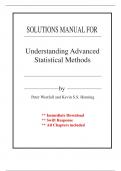SOLUTIONS MANUAL FOR
Understanding Advanced
Statistical Methods
by
Peter Westfall and Kevin S.S. Henning
** Immediate Download
** Swift Response
** All Chapters included
, Contents
1. Introduction: Probability, Statistics, and Science 1
2. Random Variables and Their Probability Distributions 5
3. Probability Calculation and Simulation 13
4. Identifying Distributions 19
5. Conditional Distributions and Independence 26
6. Marginal Distributions, Joint Distributions, Independence, and Bayes’ Theorem 30
7. Sampling from Populations and Processes 36
8. Expected Value and the Law of Large Numbers 41
9. Functions of Random Variables: Their Distributions and Expected Values 48
10. Distributions of Totals 52
11. Estimation: Unbiasedness, Consistency, and Efficiency 60
12. Likelihood Function and Maximum Likelihood Estimates 64
13. Bayesian Statistics 73
14. Frequentist Statistical Methods 79
15. Are Your Results Explainable by Chance Alone? 82
16. Chi-Squared, Student’s t, and F-Distributions, with Applications 89
17. Likelihood Ratio Tests 94
18. Sample Size and Power 99
19. Robustness and Nonparametric Methods 105
Appendix. SAS Code for Selected Problems 107
, 1
1. Introduction: Probability, Statistics, and Science
Solutions to Exercises
1. Y1 = Y0(1 + R1) implies that Y1 = Y0 + Y0R1, which in turn implies Y1 – Y0 = Y0R1, and finally that R1 =
(Y1 – Y0)/Y0.
2. To show: Y10 = Y9 (1 + R10). But R10 = (Y10 – Y9)/Y9, so 1 + R10 = Y10/Y9, implying the desired result.
3. I tried λ = 0.01, 0.5, 1.0, 2.0, 4.0. here are the first few values generated:
λ
=
0.01
λ
=
0.5
λ
=
1.0
λ
=
2.0
λ
=
4.0
0
0
1
2
5
0
0
0
0
5
0
0
0
2
3
0
1
1
1
4
0
1
3
2
6
0
0
1
1
5
0
1
0
1
1
0
0
0
2
6
0
0
1
1
5
0
2
1
6
7
0
0
1
2
5
0
0
3
2
1
0
0
0
2
4
0
1
0
5
4
According the problem description and the data generated, λ = 0.5 seem reasonable. Larger λ
predict too many sales, and λ = 0.01 predicts too few sales.
4.
A. (i) Luxury car sales processes (buyer behavior, advertising, dealership reputation); (ii) design: go
to the dealership and ask for their records, measurement: the count of sales of luxury cars in a
given day; (iii) the numeric values of sales that you will collect, (iv) the Poisson probability
distribution, (v) the numbers produced by the Poisson distribution for different λ.
B. If it produces sales data that look like sales data that you would actually see, for some values of
the parameters. By this criterion, the model with λ = 0.5 was good, or at least better than the other
choices.
C. (i), (ii) and (iii) are reality; (iv) and (v) are the model.
5. On average, is more than one car sold per day?
6. Here are some data* produced by a normal distribution with mean = 0 and standard deviation = 1.
0.295754035, -0.422794528, -0.19995241, -0.538682343, -0.820380137, 0.303595016 . These
numbers don’t look anything like car sales. For one thing, they aren’t integers. For another, some are
negative.




